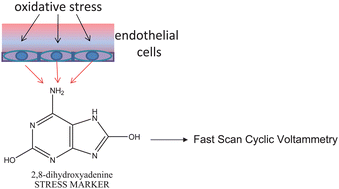Rapid measurements of 2,8-dihydroxyadenine (2,8-DHA) with a nanostructured electrochemical sensor in 5-fold diluted supernatants of endothelial cells exposed to oxidative stress
Abstract
The LOD for

* Corresponding authors
a
University of Florida, Department of Chemistry, Gainesville, USA
E-mail:
atoth@chem.ufl.edu
b King Faisal University, Department of Chemistry, Saudi Arabia
The LOD for

 Please wait while we load your content...
Something went wrong. Try again?
Please wait while we load your content...
Something went wrong. Try again?
M. Kathiwala, K. M. Abou El-Nour, R. Cohen-Shohet and A. Brajter-Toth, Analyst, 2010, 135, 296 DOI: 10.1039/B911649D
To request permission to reproduce material from this article, please go to the Copyright Clearance Center request page.
If you are an author contributing to an RSC publication, you do not need to request permission provided correct acknowledgement is given.
If you are the author of this article, you do not need to request permission to reproduce figures and diagrams provided correct acknowledgement is given. If you want to reproduce the whole article in a third-party publication (excluding your thesis/dissertation for which permission is not required) please go to the Copyright Clearance Center request page.
Read more about how to correctly acknowledge RSC content.
 Fetching data from CrossRef.
Fetching data from CrossRef.
This may take some time to load.
Loading related content
